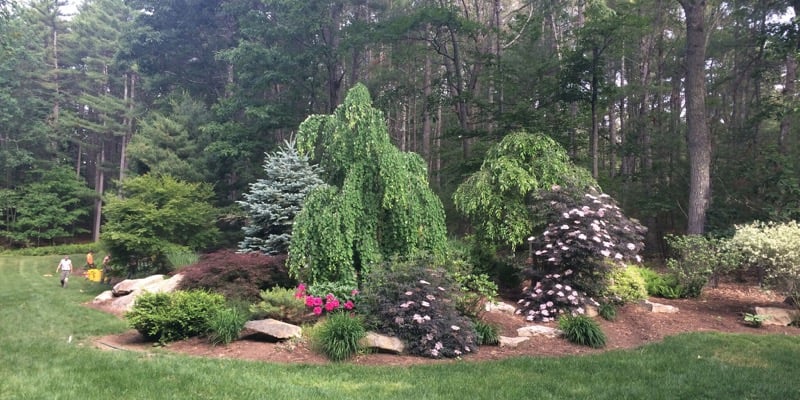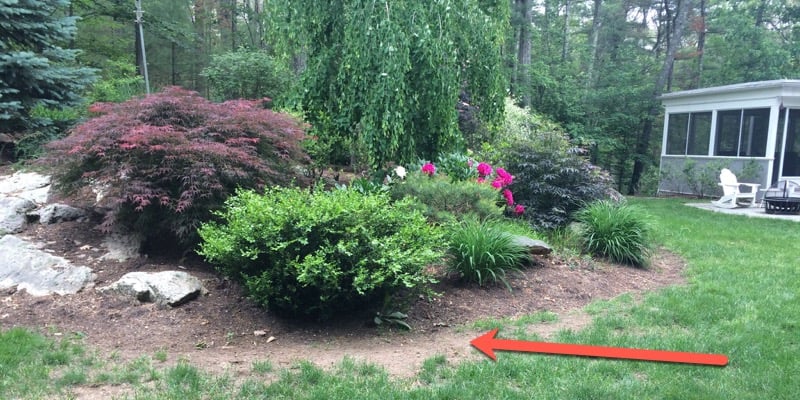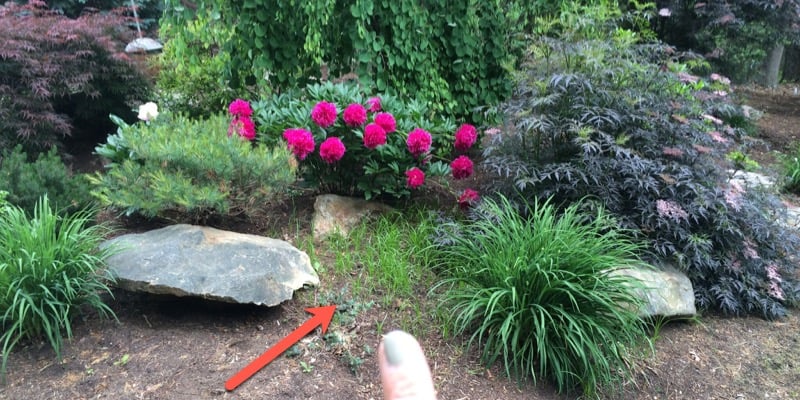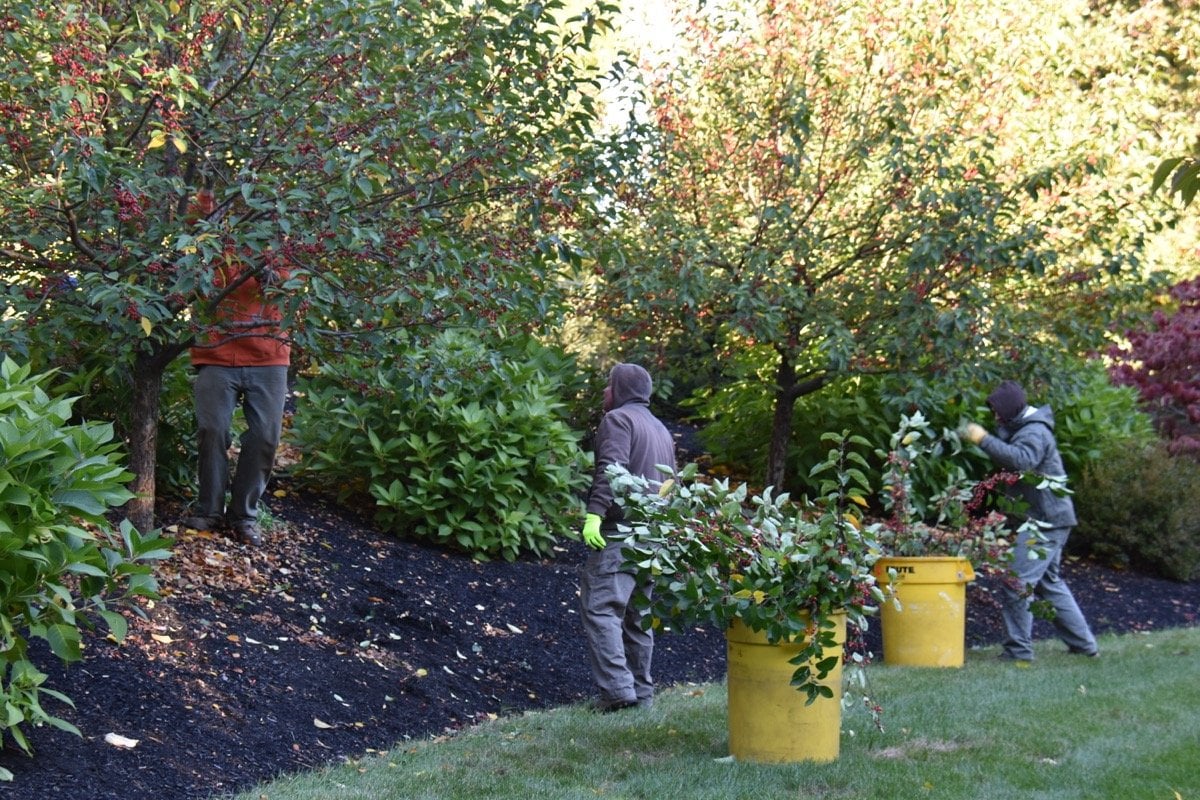Even those of us who are passionate about landscaping and gardening can be equally passionate about saving time and money doing it. Minimizing effort and expense on your landscaping chores is all about knowing the best times to perform certain tasks around your gardens and lawn. Whether it’s maintenance or planning or installing – understanding the seasons is key for making sure you time your work so that it’s cost- and time-effective.
If you’re ready to lessen your burden when it comes to maintaining your landscape and all the elements in it, here are 5 tips to make your life easier: 1. Fall is the BEST time to get ready for spring
For many people, "spring clean-up" often waits until after Memorial Day when the days are longer and weekends nicer for outside work. The problem is, once your timing is off, you can’t play catch-up – Mother Nature will simply continue to outpace you.

Identified this bed in the spring for fall renovation
Unfortunately, the commercial home and garden industry has brainwashed consumers into believing everything has to be done in the spring, including getting rid of the dead growth from the previous season. Nothing could be further from the truth. Fall is a great time to take full advantage of autumn rains, cooling temperatures, and plants slowly going to sleep for the winter. As your gardens quietly fade with the seasons, use your newly-sharpened tools (they got dull over the summer) to carefully prune dead growth (careful not to snip new buds waiting for warmer weather!) so your gardens will be ready for spring. Call it your “pre-spring clean-up.”
However, don’t be in a rush to get rid of all the fallen leaves, needles, and pine cones. Leave them alone in perimeter beds, around property borders, and in wooded areas where they’re a valuable resource for good insects and other critters. But your managed gardens -- the ones you want “cleaned” and orderly in the spring time – go ahead and clean those up now and get ahead of your springtime chores. This’ll save you time and money come springtime because you’ll be able to mulch early and help stop weeds before they get started.
2. Assess your landscape for “edits” in the late spring
Nothing promotes overspending like assessing your landscape too early in the year. The early spring months are far too transitional to make any major judgment calls on what should be updated or replaced. Some plants may have struggled through winter and need a little more time to perk back up. Mud season may hang on a little longer, leaving your landscape drab and lifeless. Just be patient, give it a little time, and wait until you have a better picture of what your landscape will look like come warmer weather. You may not have to do (or spend) as much as you think once winter recovery is complete.

Identified this edge as needing to be expanded and sharpened up
While a seasoned landscaping professional can cast an experienced eye over an early April landscape and make some calls on much of what might need to be done, we’re not magicians. We can’t conjure up a completely accurate picture of what things will look like in the weeks and months to come if we can’t see any vegetation at all.
The key is not to rush. Slow down a little. Let the spring unfold completely so you can fully articulate what transformations you’d like to see before you dive into any expensive landscaping projects – on your own or with a professional.
3. Plan for fall projects in the summertime
Once you and your landscape have gone through spring and life has fully returned, you can accurately assess your plant performance and garden composition. Now you have the data you need to design your garden edits and landscape updates over the early summer months, so you’re able to set your budgets and line up work for the fall season. By taking the time to plan, you’ll guard against wasting money on unnecessary or inadequate solutions.

Identified a troublesome weed that needed to be fully dug out in the spring before the renovation
4. Target planting projects for the fall
If you want to add or adjust the plantings in your landscape, autumn is your season because it helps prevent plant losses that occur so frequently in the hotter, more stressful summer months. New plants as well as transplants suffer and often die through drought, so save money by working with plants when you’re more likely to succeed. Mother Nature will be on your side with shortening days and cooler temps.
Also, fall is the time when roots are in active growth mode. Think of it this way -- if you’re digging up plants, damaging roots, what better time to do that than when the roots can rebound with quick attention?
Remember to hydrate plants well before you dig them up. This will help with the shock and the new acclimation efforts. Oh, and water after, too – they’re going to be thirsty after all that activity.
5. Approach hardscape projects like building a house – they’re permanent
Hardscape projects are expensive, so the best tip I have to get the most out of your money is to design, plan, and budget adequately for the job. Just because you’d like it to be less costly doesn’t mean it can be. Cutting corners to save a buck now just means you’ll probably be spending a lot more later to fix the shortcomings.
Remember, a hardscape addition such as a wall or patio should be considered a permanent, one-time effort. Think of your house -- you don’t want to go back and fix stuff after you’ve built it. Ideally, it was built right to begin with. Solid foundations for walls and patios and other hardscapes make all the difference in the world. They may cost more, but they’re also an insurance policy. Believe it or not, the earth moves -- especially if you live where winter brings deep, upheaving frosts -- so slapping a bunch of stone on top of soil isn’t going to hold, trust me.
Choose where you’ll build your hardscape features wisely. Don’t rush through it. Again, this is a permanent build, so placement is critical to success, both visually and functionally. If you’re putting your hard won dollars into hardscape be sure to learn all the ins and outs of how to succeed and build a sustainable project that will last a long, long, long time.
We love the idea of landscapes being “cheap”, but here’s the truth: they aren’t. The way we save money is to be smart and plan work to maximize wins while minimizing losses.

TWEETABLE TIP
Understand the seasons to make the most of your gardening dollars!
VIA @GardenContinuum

Learn more about Fine Gardening by downloading the eBook titled "The Fine Gardeners Guide to a Beautiful and Luxurious Landscape" today.










Leave a comment